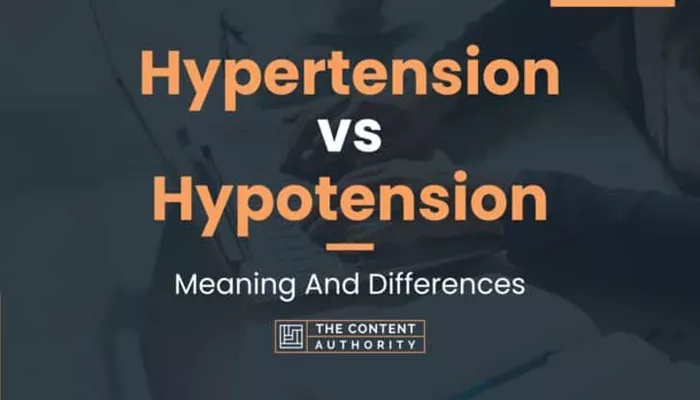Cardiovascular health is paramount to overall well-being, and understanding the nuances of blood pressure regulation is crucial. Blood pressure is the force exerted by circulating blood on the walls of blood vessels, measured in millimeters of mercury (mmHg). It consists of two readings: systolic pressure (the higher number, indicating the force during heartbeats) and diastolic pressure (the lower number, indicating the force between heartbeats).
Hypotension Defined
Hypotension, commonly known as low blood pressure, is typically defined as a systolic blood pressure less than 90 mmHg and a diastolic pressure less than 60 mmHg. It can be classified into several types, including orthostatic hypotension (a sudden drop in blood pressure when standing up) and neurally mediated hypotension (a drop in blood pressure after standing for long periods).
Hypertension Defined
Hypertension, or high blood pressure, is defined as a sustained systolic blood pressure of 130 mmHg or higher and a diastolic pressure of 80 mmHg or higher. It is categorized into primary (essential) hypertension, which has no identifiable cause, and secondary hypertension, resulting from an underlying condition such as kidney disease or hormonal disorders.
Symptoms And Implications of Hypotension
Hypotension can present with various symptoms, depending on its severity and the underlying cause. Common symptoms include dizziness, fainting, blurred vision, fatigue, and nausea. Severe hypotension can lead to shock, characterized by cold, clammy skin, rapid shallow breathing, weak pulse, and confusion.
The primary concern with hypotension is inadequate blood flow to vital organs, particularly the brain, heart, and kidneys.
Chronic hypotension can result in organ dysfunction and failure, significantly impairing the quality of life and leading to life-threatening situations.
SEE ALSO: The 7 Major Causes of Paroxysmal Hypotension
Symptoms And Implications of Hypertension
Hypertension is often referred to as a “silent killer” because it may not cause noticeable symptoms until significant damage has occurred. When symptoms do appear, they might include headaches, shortness of breath, nosebleeds, and chest pain.
The long-term consequences of untreated hypertension are severe and can include heart disease, stroke, kidney damage, and vision loss. Hypertension increases the workload on the heart, leading to hypertrophy (thickening of the heart muscle), heart failure, and an increased risk of myocardial infarction (heart attack).
Comparative Analysis: Which Is More Dangerous?
Risk of Immediate Harm
Hypotension:
The immediate risk associated with severe hypotension is the potential for shock and organ failure due to inadequate blood perfusion. Acute hypotension, if not promptly addressed, can be life-threatening. Conditions such as septic shock or severe dehydration can precipitate a rapid decline in blood pressure, necessitating urgent medical intervention.
Hypertension:
While hypertension may not pose an immediate risk, its insidious nature means that it can cause significant damage over time. However, hypertensive crises (extremely high blood pressure) can occur, leading to acute complications such as stroke, heart attack, or aortic dissection, which require emergency treatment.
Long-term Health Impact
Hypotension:
Chronic hypotension can lead to persistent symptoms that affect daily life, such as fatigue and dizziness, but it is generally considered less dangerous than hypertension in terms of long-term health impact. However, in certain populations, such as the elderly, persistent low blood pressure can contribute to falls and fractures.
Hypertension:
The long-term effects of hypertension are more pronounced and severe. It is a major risk factor for cardiovascular diseases, including coronary artery disease, heart failure, and stroke. Hypertension is also linked to chronic kidney disease and peripheral artery disease. The cumulative damage to blood vessels and organs makes hypertension a leading cause of morbidity and mortality worldwide.
Management And Treatment Approaches
Managing Hypotension:
Lifestyle Modifications:
Increase salt intake (under medical supervision) to raise blood pressure.
Stay hydrated to maintain adequate blood volume.
Avoid alcohol, which can lower blood pressure.
Wear compression stockings to improve blood flow.
Medications:
Fludrocortisone can help increase blood volume.
Midodrine can raise blood pressure by constricting blood vessels.
Addressing Underlying Causes:
Treating conditions such as dehydration, heart problems, or endocrine disorders that contribute to low blood pressure.
Managing Hypertension:
Lifestyle Modifications:
Reduce salt intake to lower blood pressure.
Adopt a healthy diet rich in fruits, vegetables, and whole grains.
Engage in regular physical activity.
Limit alcohol consumption and avoid smoking.
Maintain a healthy weight.
Medications:
Diuretics to help remove excess fluid from the body.
ACE inhibitors and ARBs to relax blood vessels.
Beta-blockers to reduce heart rate and cardiac output.
Calcium channel blockers to prevent calcium from entering heart and blood vessel walls.
Conclusion
Both hypotension and hypertension pose significant health risks, but they differ in their immediate and long-term dangers.
Hypotension can lead to acute, life-threatening situations if severe and untreated, but chronic hypotension is generally less harmful than chronic hypertension. Hypertension, although often asymptomatic initially, causes substantial long-term damage to the cardiovascular system and other organs, making it a leading cause of morbidity and mortality.

